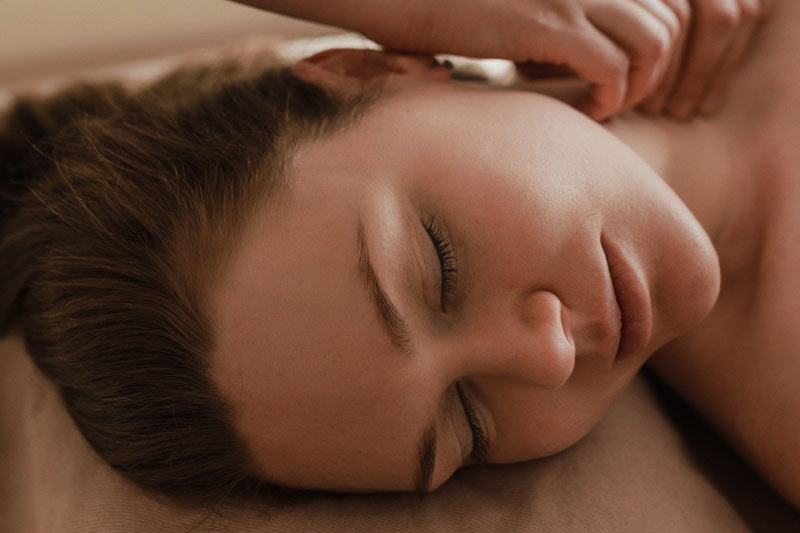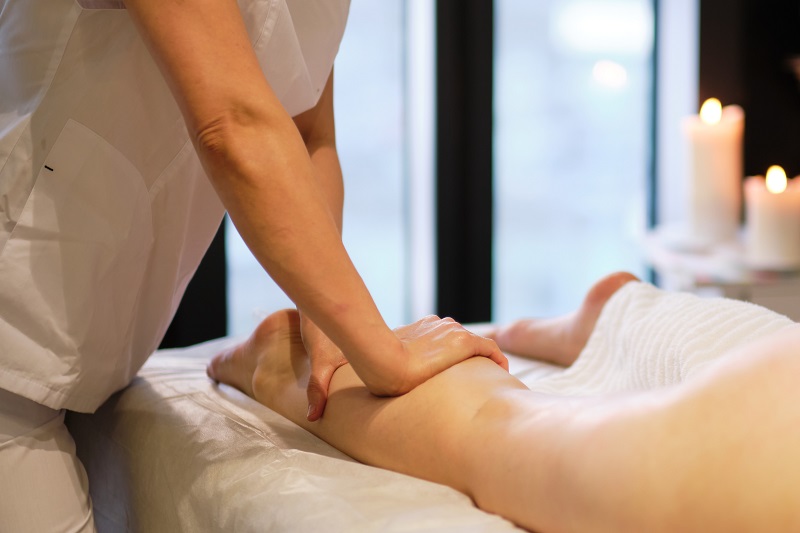The lymphatic system is an important part of our circulatory and immune systems, removing excess fluid from tissues, filtering waste and toxins from the body, and keeping infections at bay.
When the lymphatic system malfunctions due to a medical condition or treatment, the lymphatic drainage massage is an effective way to restore its function and relieve uncomfortable symptoms.
This article explains how the lymphatic drainage massage works and what benefits to expect from the therapy.

What Is a Lymphatic Drainage Massage?
A lymphatic drainage massage is a specialized form of massage therapy involving gentle movements and light pressure to improve lymphatic flow and relieve the symptoms of fluid retention.
When the heart pumps blood to deliver oxygen and nutrients to tissues and organs, part of the fluid from the bloodstream leaks into the tissues. This fluid is called lymph. The lymphatic system’s role is to return the lymph into the bloodstream, filtering potential pathogens through the lymph nodes before it reaches the blood.
The lymphatic drainage massage is a recommended treatment for lymphedema (tissue swelling due to lymph accumulation), but it is also gaining popularity as a wellness and skin rejuvenation treatment.
Types of Lymphatic Drainage Massage
There are two main types of lymphatic drainage massage:
1. Manual Lymphatic Drainage (MLD)
Manual lymphatic drainage is a professional massage performed by trained specialists. Massage therapists usually use the following MLD techniques:
- Vodder – This method was named after Dr. Vodder, who studied swollen lymph nodes and developed the manual lymphatic drainage technique. It involves massaging the patient using four basic movements: sweeping motions, stationary circles, pumping movements, and rotary movements.
- Foldi – This technique is an extension of the Vodder method. It involves alternating between massaging the patient and moments of relaxation, including deep breathing.
- Casley-Smith – In this technique, the therapist mainly uses the sides and palms of the hands, massaging the patient in slow, repetitive, circular motions. The method often incorporates compression bandaging as part of the treatment protocol.
- Leduc – Involves making slow, circular movements in a single direction to improve lymphatic flow. The technique often combines lymphatic drainage with other massage elements, such as deep tissue massage and myofascial release.
A manual lymphatic drainage massage typically takes 30-60 minutes.
Note: Learn how intraoral massage can help reduce pain, stress, and provide anti-aging benefits.
2. Simple Lymphatic Drainage (SLD)
Simple lymphatic drainage massage is a self-massage method that therapists sometimes prescribe to patients to do at home. Patients learn which areas to massage and how much pressure to apply. SLD isn’t as thorough as MLD and involves simplified hand movements. The patients rub only the areas that are not swollen, freeing up space for the lymph from the swollen area to drain into.
At-home lymphatic drainage usually takes about 10-20 minutes.
Lymphatic Drainage Massage Benefits
Scientists are still studying the effects of lymphatic drainage massage. Clinical experience suggests it provides the following benefits.
1. Helps Relieve Symptoms of Certain Medical Conditions

Drainage massage is often used to treat lymphedema patients. This condition is characterized by the swelling of arms and legs due to cancer treatments, surgery, genetic disorders, infection, and injury. The massage may also help relieve swelling, pain, and stiffness in patients with rheumatoid arthritis, fibromyalgia, lipedema, and chronic venous insufficiency.
2. Improves Circulation
Lymphatic drainage massage indirectly improves circulation by removing toxins and waste products from tissues and by reducing swelling, which can restrict blood flow.
3. Increases Relaxation and Alleviates Stress
Lymphatic drainage involves gentle, rhythmic motions close to the skin’s surface that ease muscle tension and promote calmness. Studies also show that massage stimulates the parasympathetic nervous system, which reduces stress and tension and helps patients relax.
4. May Stimulate the Immune System
Lymphatic drainage massage reroutes blocked lymph to healthy lymph nodes, helping filter toxins, waste, and pathogens. Eliminating harmful substances may reduce the risk of infections and illness, improving immune function.
5. May Help with Skin Conditions

Trapped lymph around and above the neck containing toxins, debris, and inflammatory cells often causes skin conditions such as acne, edema, eczema, and psoriasis. Lymphatic drainage massage moves the lymph and inflammatory cells down, below the neck, clearing problematic facial skin.
Note: Read about the best holistic acne treatments and learn how to prevent breakouts using natural remedies.
6. May Help Rejuvenate the Skin
Removing excess fluid with a facial lymphatic drainage massage may help reduce swelling, lift and tighten the skin, and temporarily rejuvenate the face.
7. May Improve Cellulite
By reducing fluid retention and swelling, lymphatic drainage massage reduces the amount of fluid pressing against the fibers beneath the skin. It can help improve the appearance of cellulite.
How Do I Know if I Need Lymphatic Drainage?
You can benefit from lymphatic drainage if you notice the following symptoms:
- Swelling in the arms and legs
- Swollen lymph nodes
- Stiff joints
- Muscle pain
- Depression
- Constant tiredness
- Bloating
- Problems with digestion
- Constipation
- Brain fog
- Dull, dry, or itchy skin
- Allergies
Some of these symptoms can also be signs of more serious conditions so make sure you consult your physician before scheduling a lymphatic drainage massage.
How to Prepare for Lymphatic Drainage Massage?

The following tips will help you prepare for lymphatic drainage massage and reduce the risk of side effects.
- Drink plenty of water before (and after) the massage to encourage lymph flow.
- Eat a light meal before the treatment.
- Don’t take ibuprofen and other blood thinners one week before the massage to reduce the risk of bruising.
- Wear loose, comfortable clothing to reduce discomfort and avoid impeding natural lymph flow.
What to Expect During Lymphatic Drainage Massage?
Patients usually lie on their backs. If they have lymphedema in their head and neck, they sit up. The massage therapy starts with deep breathing exercises to prepare the lymphatic vessels and lymph nodes for the massage.
The therapist first massages the lymph nodes and areas that are not swollen to create space for the lymph to drain to. They use light movements because lymphatic vessels are close to the skin’s surface.
The therapist then moves to blocked lymph nodes, stretching the skin in the direction of healthy lymph nodes and toward the heart.
If the patient requires full body therapy, the therapist usually starts with the back of the legs and proceeds up the back. Then they move to the front of the body, finishing at the neck and face. Patients can also have partial treatments.
Holistic estheticians use lymphatic drainage as part of their holistic facial routine to stimulate the flow of nutrients, remove metabolic waste, and clear the skin.
What Happens to Your Body After a Lymphatic Drainage?

The immediate effects of lymphatic drainage are a relaxed state and a feeling of lightness. Some patients report feeling energized, and some sleep better.
Though lymphatic drainage massage therapists use light pressure, patients can experience soreness for a few days. An additional positive side effect is increased muscle and joint mobility.
After a time, many patients observe a reduction in swelling and other uncomfortable symptoms (headache, fatigue, etc.).
Are There Any Side Effects of Lymphatic Drainage Massage?
Lymphatic drainage massage is a gentle and generally safe treatment. However, because of its detoxing qualities, patients can experience the following symptoms:
- Increased urination
- Nausea
- Diarrhea
- Fatigue
- Dizziness
- Headache
When Should You See a Doctor?
Seek medical help if you experience extreme tiredness, pain or if the swelling gets worse. Also, contact your medical provider if you have lymphedema and don’t see an improvement in your condition after a series of lymphatic drainage sessions.
When Should You Not Do Lymphatic Drainage Massage?
Though lymphatic drainage is a safe procedure, some health conditions prevent patients from receiving the treatment. They include:
- Active infections
- Heart conditions
- Blood clotting
- Kidney disorders
- High blood pressure
- Chronic inflammation
- Pregnancy
Lymphatic Drainage Cost
The cost of a lymphatic drainage massage session ranges from $50 to $200, depending on the duration, treatment areas, and the location of the med spa.
Our Vibrant Skin Bar skin professionals offer Lymphatic Lift at $199. It is a non-invasive facial treatment combining lymphatic drainage with buccal massage to lift, tighten, and rejuvenate the skin.
Conclusion
Lymphatic drainage massage is a gentle manual therapy that can improve various medical and skin conditions. It is a low-risk treatment but requires seeing a trained and experienced therapist for optimal results.
Contact our skin experts at Vibrant Skin Bar for a consultation. They’ll create a customized treatment plan to help you achieve your health and beauty goals.


